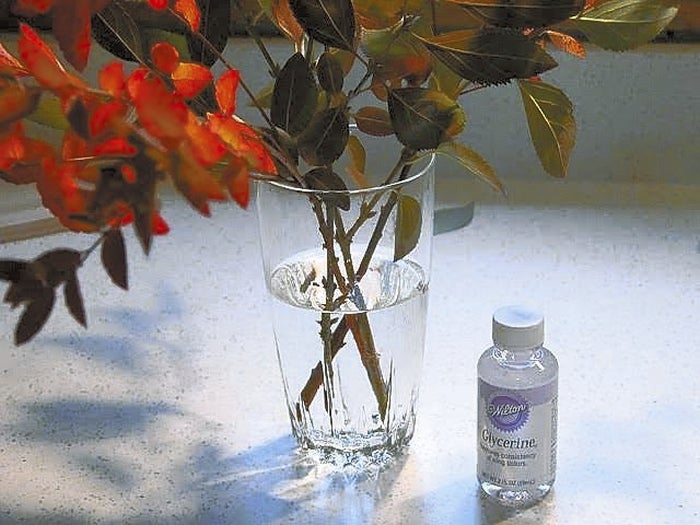Toi Degree: Preserving fall leaves and Jack-O’-lanterns
Published 12:00 am Sunday, October 18, 2015

- Glycerin helps fall leaves keep their color longer. Cooperative Extension
As I have driven throughout the county, I noticed the beautiful fall decorations on porches, fences, doors and in yards. I sure wish I was as creative as those homeowners or had time to put things together like that. For the most part, my fall decorations consist of a few mums on the front porch and maybe a wreath on the door. So I know that after all the hard work these people have put into decorating, they would like to keep them looking good as long as possible! There are a few things that you can do keep your fall decorations in pristine shape.
Preserving fall leaves and branches.
There are many ways to preserve fall leaves, from pressing to waxing to drying. Preserving with glycerin is unique; it keeps the leaves supple and soft and preserves quite a bit of the color. Glycerin-preserved leaves are perfect for crafts, arrangements and wreaths, and the process is incredibly easy.
What you’ll need to preserve the leaves:
• Leaves
• Glycerin
• Water
• Measuring spoon
• Jar
You can take branches from your favorite fall leaves; for instance, maple leaves are beautiful in the fall. Insert them into a glycerin solution. Make the solution of two parts water and one part glycerin. Glycerin is a product you should be able to find at your local craft store.
Start with putting two teaspoons of water to one teaspoon of glycerin and mix it all up. To help your branches absorb it best, make a fresh cut at the bottom of the stem, and just drop it in. It’s that simple. All you have to do is allow it to sit in the solution for a couple of weeks. If you want to preserve and add an extra pop of color to individual leaves, you can do the same thing. Just insert your leaves into the glycerin solution to add more color to your leaves; just add in a couple of drops of food coloring. The food coloring will be absorbed by the stems into the leaves, giving them even more vibrant color.
Preserving a carved pumpkin
I must say I did quite a bit of research on this one and found a few things that could keep your Jack-O’-lantern smiling a little longer.
1. Soak the pumpkin in a bleach solution. Mix together one tablespoon of bleach and one quart of water. Let the pumpkin soak in this solution for at least one to eight hours.
The water is intended to hydrate the pumpkin flesh and prevent it from drying out too quickly. The bleach is an antimicrobial agent that will kill most of the surface bacteria and mold spores on the pumpkin.
2. Wipe the pumpkin dry. Use a clean rag or paper towel to remove the moisture that pools inside the pumpkin. Too much moisture can cause the pumpkin to rot. Dry the outside of the pumpkin, as well.
3. Spray with additional bleach. Combine one tablespoon of bleach with one quart of water in a spray bottle. Douse the exposed flesh with this strong bleach solution.
The bleach used in the soaking solution was a small amount, only intended to stop the growth of surface bacteria. Using too much bleach in the soaking solution can weaken the pumpkin. Spraying the pumpkin with a stronger bleach solution after soaking it will sanitize it without weakening the structure of the pumpkin.
Commercial pumpkin preservers are also an option. There is a product called Pumpkin Fresh that is an alternative to petroleum jelly, bleach and lemon juice treatments. Pumpkin Fresh is usually available where pumpkins are sold. It is specially designed to help keep a carved Jack-o’-lantern fresh. If you opt for this method, you may want to buy two.
4. Coat the cut areas with petroleum jelly. Rub all of the exposed flesh with a fine coating of petroleum jelly.
The petroleum jelly will lock in moisture, preventing the pumpkin from dehydrating as quickly as it might otherwise. It will also block out new bacteria and mold.
Be sure that the petroleum jelly is applied only after first using bleach. The bleach is needed in order to kill bacteria and mold already on the pumpkin. Skipping this step and going straight to the petroleum jelly will actually trap preexisting bacteria and mold on the surface of the pumpkin, thereby speeding the decay process.
Vegetable oil or a vegetable oil spray could also be used instead of petroleum jelly.
5. Keep the pumpkin cool and moist. Display your pumpkin in a spot that does not receive direct sunlight. A shaded area works best.
Heat will speed the decaying process; placing it in a dry area will cause the flesh to dehydrate.
When not in use, consider storing the pumpkin in a refrigerator or draping a damp towel over it.
The same process is suggested for small decorative pumpkins and gourds, as well. Soak them in a bath of 10 parts water to one part bleach for 10 minutes. Dry them off. Then, buff with Vaseline and a soft cloth to make them shiny.
Toi N. Degree is a family and consumer education agent at the Rowan County Cooperative Extension. Contact her at 704-216-8970 or toi_degree@ncsu.edu


